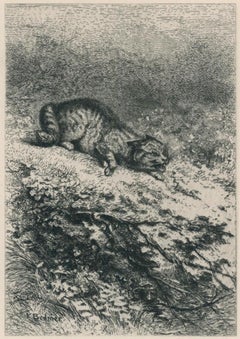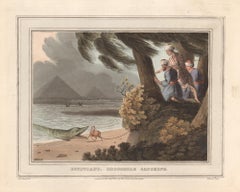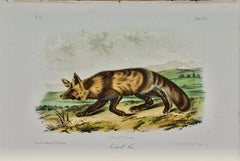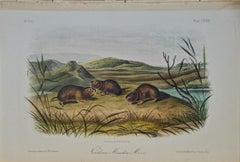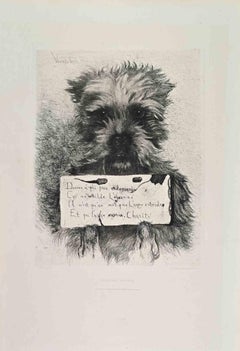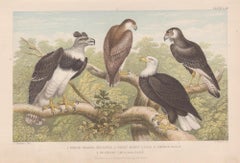19th Century Animal Prints
to
147
1,251
120
36
17
9
Overall Width
to
Overall Height
to
914
15
6
4
2
2
114
77
37
37
26
709
1,434
2,639
1,823
32
29
66
169
101
137
248
605
362
338
678
801
617
14
1,091
618
260
228
223
98
83
82
78
77
64
57
57
55
45
45
40
40
33
32
809
315
264
224
72
72
841
315
260
Period: 19th Century
The Wild Cat (Chat Sauvage)
By Karl Bodmer
Located in Middletown, NY
Etching on cream laid paper, full margins. From Eaux-Fortes Animaux & Paysages. [Beraldi II.140.34] Henri Béraldi Les graveurs du XIXe siècle: Guide de l'amateur d'estampes modernes. Librairie L. Conquet, vol. XII, Paris, 1885–1892, cat. no. 34, p. 140.
__________
Well known in his native Germany as a watercolorist, Karl Bodmer had a rich experience exploring in North America in the 19th century, accompanying German explorer Prince Maximilian zu Wied-Neuwied as the official artist on an expedition which toured the Missouri River...
Category
Barbizon School 19th Century Animal Prints
Materials
Laid Paper, Etching
Egyptians, Crocodile Catching, aquatint engraving hunting print, 1813
Located in Melbourne, Victoria
'Egyptians, Crocodile Catching'
Colour aquatint by Mathew Dubourg (1786-1838) after John Heavenside Clark (c1770-1863).
From Samuel Howitt's 'Foreign Field Sports'. Samuel Howitt w...
Category
Naturalistic 19th Century Animal Prints
Materials
Aquatint
Jackall Fox: An Original 19th C. Hand-colored Lithograph by John J. Audubon
Located in Alamo, CA
This is an original 19th century John James Audubon hand colored lithograph entitled "Jackall Fox", No. 31, Plate CLI, 151, from Audubon's "Quadrupeds of North America", printed and ...
Category
Naturalistic 19th Century Animal Prints
Materials
Lithograph
"Northern Meadow Mouse" an Audubon Hand Colored by J.T. Bowen Lithograph
Located in Alamo, CA
An original 19th century John James Audubon hand colored lithograph entitled "Northern Meadow Mouse", No. 26, Plate CXXIX, 129, from Audubon's "Quadrupeds of North America", printed ...
Category
Naturalistic 19th Century Animal Prints
Materials
Lithograph
Pour les Pauvres - Etching by Ludovic-Napoléon Lepic - Late 19th Century
Located in Roma, IT
Pour les Pauvres is a black and White etching realized in the Late 19th Century.
Titled in the lower
Image Size: 35x26
Very good impression.
Realized by Cadart for the "Société ...
Category
Impressionist 19th Century Animal Prints
Materials
Etching
Eagles, English antique bird engraving print, 1879
Located in Melbourne, Victoria
Eagles
Wood-engraving with original colouring. 1879.
160mm by 245mm (sheet).
Key below the image. From Oliver Goldsmith's 'A History of the Earth and Animated Nature'.
Category
Victorian 19th Century Animal Prints
Materials
Engraving
Lizards, antique natural history reptile chromolithograph print, circa 1895
Located in Melbourne, Victoria
'Echsen I'
Lizards - chromolithograph from a German natural history series.
Key to lizards below the image.
Gustav Mutzel was a German artist famous ...
Category
Victorian 19th Century Animal Prints
Materials
Lithograph
Swift Fox: An Original 19th Century Hand-colored Lithograph by John J. Audubon
Located in Alamo, CA
This is an original 19th century John James Audubon hand-colored lithograph entitled "Swift Fox", No. 11, Plate LII, from Audubon's "Viviparous Quadrupeds of North America", printed ...
Category
Naturalistic 19th Century Animal Prints
Materials
Lithograph
Hunting the Camelopard (Giraffe), antique African hunting engraving print, 1813
Located in Melbourne, Victoria
Colour aquatint after Samuel Howitt (1756/7-1822).
From Samuel Howitt's 'Foreign Field Sports' Samuel Howitt was an English painter, illustrator and etch...
Category
Naturalistic 19th Century Animal Prints
Materials
Aquatint
Canada Porcupine: An Original 19th C. Hand-colored Lithograph by John J. Audubon
Located in Alamo, CA
This is an original 19th century John James Audubon hand-colored lithograph entitled "Canada Porcupine", No. 8, Plate XXXVI, from Audubon's "Viviparous Quadrupeds of North America", ...
Category
Naturalistic 19th Century Animal Prints
Materials
Lithograph
Canada Lynx: An Original 19th Century Hand-colored Lithograph by John J. Audubon
Located in Alamo, CA
This is an original 19th century John James Audubon hand-colored lithograph entitled "Canada Lynx, Male", No. 4, Plate XVI, from Audubon's "Viviparous Quadrupeds of North America", p...
Category
Naturalistic 19th Century Animal Prints
Materials
Lithograph
19th century color lithograph horses chariot figures dynamic landscape
Located in Milwaukee, WI
"Fast Trotting in the West (Milwaukee Race)" is an original hand-colored lithograph published by Currier & Ives. It depicts two horses pulling racing carts. The text below the picture reads "Fast Trotting in the West...Lucy and Goldsmith Maid...trotting their closely contested race over the cold spring course Milwaukee, Wis. Sept. 6th 1871...Where Goldsmith Maid won the 2nd heat in 2:17!! The fastest Mile heat in harness on record. Purse $4000 $2500 to 1st $1500 to 2nd horse____ 8 in. in harness. TIME 2:20 1/2 2:17 2:20"
16 3/4" x 26" image
22" x 27 3/4" paper
35 3/4" x 41 7/8" frame
Currier & Ives produced their prints in a building at 33 Spruce Street where they occupied the third, fourth and fifth floors. The third floor was devoted to the hand operated printing presses that were built by Nat's cousin, Cyrus Currier, at his shop Cyrus Currier & Sons in Newark, NJ. The fourth floor found the artists, lithographers and the stone grinders...
Category
19th Century Animal Prints
Materials
Lithograph
Retriever Crossed with a Setter
Located in Columbia, MO
Retriever Crossed with a Setter
1887
Etching
3 x 5
Category
Naturalistic 19th Century Animal Prints
Materials
Etching
Bulls Fighting /// Antique Victorian Animal Landscape Etching Landscape Horse
By James Ward
Located in Saint Augustine, FL
Artist: (after) James Ward (English, 1769-1859)
Title: "Bulls Fighting"
Portfolio: The Portfolio
*Signed by Wise in pencil lower right. It is also signed in the plate (printed signat...
Category
Victorian 19th Century Animal Prints
Materials
Laid Paper, Etching, Intaglio
Le Chat et les Fleurs (from "Les Chats par Champfleury")
Located in Kansas City, MO
Edouard Manet
Le Chat et les Fleurs (from "Les Chats par Champfleury")
1869
Etching and aquatint on Rives paper
Image: 6.25 x 5.125 (17.3 × 13 cm)
Plate: 8 x 6 inches (20.3 x 15.2 c...
Category
Impressionist 19th Century Animal Prints
Materials
Etching, Aquatint
Two Guinea Fowl
By Joseph Wolf
Located in London, GB
WOLF, Joseph (artist).
Two Guinea Fowl
London For the author, Red Lion Court, Fleet Street 1871
Two original hand-coloured lithographic plates by Joseph Smit after Joseph Wolf. ...
Category
19th Century Animal Prints
Materials
Paper, Watercolor, Gouache, Lithograph
Long-Haired Squirrel: Original 19th Century Hand-colored Lithograph by Audubon
Located in Alamo, CA
This is an original John James Audubon hand-colored lithograph entitled "Long Haired Squirrel, No. 6, Plate XXVII", from John James Audubon's Quadrupeds of North America, published i...
Category
Naturalistic 19th Century Animal Prints
Materials
Lithograph
Song Thrush etc, English antique bird engraving print, 1879
Located in Melbourne, Victoria
'Song Thrush etc'
Wood-engraving with original colouring. 1879.
160mm by 245mm (sheet).
Key below the image. From Oliver Goldsmith's 'A History of the Earth and Animated Nature'.
Category
Victorian 19th Century Animal Prints
Materials
Engraving
"King Duck": An Original First Octavo Edition Audubon Hand-colored Lithograph
Located in Alamo, CA
This is an original John James Audubon hand-colored royal first octavo edition lithograph entitled "King Duck, 1. Male, 2. Female", No. 81, Plate 404, from A...
Category
Naturalistic 19th Century Animal Prints
Materials
Lithograph
Le Cirque (The Circus) II
Located in San Francisco, CA
This artwork titled "Le Cirque (The Circus) II" is an original colors lithograph on Arches paper by noted French artist Camille Hilaire, 1916-2004. It is hand signed and inscribed C/...
Category
Impressionist 19th Century Animal Prints
Materials
Lithograph
Eagle Fischerman - Etching by Johann Friedrich Naumann - 1840
Located in Roma, IT
Eagle Fisherman is an etching hand colored realized by Gotthilf Heinrich von Schubert - Johann Friedrich Naumann, Illustration from Natural history of birds in pictures, published by...
Category
Modern 19th Century Animal Prints
Materials
Etching
Downy Squirrel: An Original 19th Century Hand-colored Lithograph by Audubon
Located in Alamo, CA
This is an original John James Audubon hand-colored lithograph entitled "Downy Squirrel, No. 5, Plate XXV", from John James Audubon's Quadrupeds of North America, published in Philad...
Category
Naturalistic 19th Century Animal Prints
Materials
Lithograph
Cetaces - Dauphin ordinaire (Dolphin), French antique engraving
Located in Melbourne, Victoria
'Cetaces - Dauphin ordinaire'
Engraving with original hand-colouring by Beyer after Edouard Travies (1809-1865).
From Dictionaire Universel d'Histoir...
Category
Naturalistic 19th Century Animal Prints
Materials
Engraving
"Blue Bird Feeding Her Chicks" Attributed to T'eih Tao-jen, Printed in U.S.A.
Located in Chesterfield, MI
Print Measures 18 x 24in.
Good Condition.
Printed in U.S.A.
Category
19th Century Animal Prints
Materials
Lithograph
Great Tit Birds: A 19th C. Hand-colored Folio-sized Lithograph by John Gould
Located in Alamo, CA
This is a beautiful and vibrant hand-colored folio-sized lithograph entitled "Parus Major (Great Tit birds) by John Gould from his monograph "The Birds of Great Britain ", published ...
Category
Naturalistic 19th Century Animal Prints
Materials
Lithograph
Le Cirque (The Circus) IV
Located in San Francisco, CA
This artwork titled "Le Cirque (The Circus) IV" is an original colors lithograph on Arches paper by noted French artist Camille Hilaire, 1916-2004. It is hand signed and inscribed I/...
Category
Impressionist 19th Century Animal Prints
Materials
Lithograph
Finland Bear Hunting, aquatint engraving hunting snow print, 1813
Located in Melbourne, Victoria
'Finland Bear Hunting'
Colour aquatint by Mathew Dubourg (1786-1838) after Manschirch.
From Samuel Howitt's 'Foreign Field Sports'. Samuel Howitt was an English painter, illustrato...
Category
Naturalistic 19th Century Animal Prints
Materials
Aquatint
Yellow-billed Cuckoo: An Original 1st Ed. Audubon Hand-colored Bird Lithograph
Located in Alamo, CA
This is an original 1st octavo edition John James Audubon hand-colored lithograph entitled "Yellow-billed Cuckoo, 1. Male, 2, Female, Papaw Tree", No. 55, Plate 275 from Audubon's "B...
Category
Naturalistic 19th Century Animal Prints
Materials
Lithograph
Mr. Monkey Painter Set Off - Original Lithograph by J.J Grandville - 1852
Located in Roma, IT
Mr.Monkey Painter Set Off is an original lithograph on ivory-colored paper realized by J.J. Grandville from Scènes de la vie privée et publique des animaux, 1852. Published by Manesq...
Category
Modern 19th Century Animal Prints
Materials
Paper, Lithograph
The Bee Bride - Original Lithograph by J.J Grandville - 1852
Located in Roma, IT
The Bee Bride is an original lithograph on ivory-colored paper realized by J.J. Grandville from Scènes de la vie privée et publique des animaux, 1852. Published by Manesq & Harvard, ...
Category
Modern 19th Century Animal Prints
Materials
Paper, Lithograph
White Weasel Sloat: An Original 19th Century Hand-colored Lithograph by Audubon
Located in Alamo, CA
This is an original John James Audubon hand-colored lithograph entitled "White Weasel Slout, No. 12, Plate LIX" from John James Audubon's Quadrupeds of North America, published in Ph...
Category
Naturalistic 19th Century Animal Prints
Materials
Lithograph
The Petition - Original Lithograph by J.J Grandville - 1852
Located in Roma, IT
The Petition is an original lithograph by J.J. Grandville from "Scènes de la vie privée et publique des animaux, 1852. Published by Manesq & Harvard, Paris.
Good Conditions but age...
Category
Modern 19th Century Animal Prints
Materials
Paper, Lithograph
Polish Swan - Woodcut Print by Alexander Francis Lydon - 1870
Located in Roma, IT
Polish Swan is a modern artwork realized in 1870 by the British artist Alexander Francis Lydon (1836-1917) .
Woodcut print on ivory-colored paper.
Hand-colored, published by Londo...
Category
Modern 19th Century Animal Prints
Materials
Woodcut
Willet or Stone Curlew: A First Octavo Edition Audubon Hand-colored Lithograph
Located in Alamo, CA
This is an original John James Audubon hand-colored royal first octavo edition lithograph entitled "Semipalmated Snipe, Willet or Stone Curlew, 1. ...
Category
Naturalistic 19th Century Animal Prints
Materials
Lithograph
Le Beau Monde aux Tuileries - Lithograph by J.J Grandville - 1852
Located in Roma, IT
Le Beau Monde aux Tuileries is an original lithographs by J.J. Grandville from "Scènes de la vie privée et publique des animaux, 1852. Published by Manesq & Harvard, Paris.
Good Co...
Category
Modern 19th Century Animal Prints
Materials
Paper, Lithograph
Black-headed Pitta Birds: A 19th C. Hand-colored Lithograph by John Gould
Located in Alamo, CA
This is a hand-colored folio-sized lithograph entitled "Pitta Atricapilla (Black-headed Pitta) by John Gould, which is plate 19 from his monograph "The Birds of Asia", published in L...
Category
Naturalistic 19th Century Animal Prints
Materials
Lithograph
"Texan Lynx": An Original Audubon 19th Century Hand-Colored Quadruped Lithograph
Located in Alamo, CA
This is an original 19th century John James Audubon hand-colored lithograph entitled "Texan Lynx", No. 19, Plate XCII, 92, from Audubon's "Quadrupeds of North America", printed and colored by J.T. Bowen and published in Philadelphia from 1849-1854. The lithograph depicts a Texan Lynx laying on the ground with hills in the background.
This antique hand colored Audubon quadruped lithograph is presented with the original descriptive text pages 293-296 from Audubon's 19th century publication. The print is in excellent condition, including the striking hand coloring.
John James Audubon (1785-1851) was a naturalist and artist. He was initially unsuccessful financially prior to the publication of his famous work “The Birds of America”, spending time in debtor’s prison, once stabbing a disgruntled investor in self-defense. However, his obsession with birds and art motivated him to persist in his goal of documenting every bird in America via his watercolor paintings and publishing his works for all to enjoy. Audubon's first illustrations were published in a large elephant folio size. Due to their expense they were purchased in rather small numbers by the wealthy. To reach a larger audience, Audubon, with the help of his sons and J. T. Bowen, published a smaller octavo sized lithograph version, which were much more affordable.
With the success of his bird projects, Audubon then turned his attention to four-legged animals. He explored the Missouri River in 1843 sketching the four-legged animals he encountered in their natural setting. His expedition covered some of the same regions recently explored by Lewis and Clark, traveling from present day Alaska to Mexico. Audubon realized that this was an opportunity to document these animals in the still relatively pristine American wilderness, before man encroached on their environment.
Between 1845 and 1848, Audubon and his sons John Woodhouse Audubon and Victor Gifford Audubon produced a set of elephant folio sized lithographs that were primarily engraved and hand colored by J. T. Bowen in Philadelphia. The publication, which included text descriptions of the animals was published 3 years before Audubon died. As with the birds, this was followed by a three-volume set of 155 octavo-sized plates entitled “The Quadrupeds of North America” completed and published by Audubon’s sons, John, Jr. and Victor.
Audubon prints continue to be popular and a wise investment. The double elephant folio set...
Category
Naturalistic 19th Century Animal Prints
Materials
Lithograph
'Le maréchal flamand' (The Flemish Blacksmith) — 19th-Century French Romanticism
Located in Myrtle Beach, SC
Théodore Géricault 'Le maréchal flamand' (The Flemish Blacksmith) from the series ‘Etudes, de chevaux lithographiés,’ lithograph, 1822, 2nd state ...
Category
Romantic 19th Century Animal Prints
Materials
Lithograph
The Monkey - Original Lithograph by Paul Gervais - 1854
By Paul Gervais
Located in Roma, IT
The Monkey is an original lithograph on ivory-colored paper, realized by Paul Gervais (1816-1879). The artwork is from The Series of "Les Trois Règnes de la Nature", and was publishe...
Category
Modern 19th Century Animal Prints
Materials
Lithograph
Full Practice. Terrier dogs. 19th century mixed method engraving, circa 1865
Located in Melbourne, Victoria
'Full Practice', mixed method engraving published in New York, circa 1865.
After the painting by George Armfield.
475mm by 610mm (platemark)
505mm by 645mm (sheet)
Category
Victorian 19th Century Animal Prints
Materials
Engraving
Antique Dog Lithograph, Taste of Alfred De Dreux, France circa 1870 Greyhounds D
By Alfred de Dreux
Located in SANTA FE, NM
Antique Dog Portrait
Lithograph in the Taste of Alfred De Dreux
Greyhounds D
France, circa 1870
Lithography
25 5/8 x 19 5/8 (28 x 20 frame) inc...
Category
Romantic 19th Century Animal Prints
Materials
Lithograph
Platalea Leucorodia (Spoonbill) /// Ornithology John Gould Animal Art Shorebird
By John Gould
Located in Saint Augustine, FL
Artist: John Gould (English, 1804-1881)
Title: "Platalea Leucorodia (Spoonbill)" (Vol. 4, Plate 32)
Portfolio: The Birds of Great Britain
Year: 1862-1873
Medium: Original Hand-Colore...
Category
Victorian 19th Century Animal Prints
Materials
Watercolor, Lithograph
Ass and the Lion Hunting, antique animal fable etching by Samuel Howitt
Located in Melbourne, Victoria
Original antique etching by Samuel Howitt (1756-1822) . C1810. Published by Edward Orme.
An early 19th century etching by Howitt from a series depicting ...
Category
Naturalistic 19th Century Animal Prints
Materials
Engraving, Etching
American Wigeon - Woodcut Print by Alexander Francis Lydon - 1870
Located in Roma, IT
American Wigeon is a modern artwork realized in 1870 by the British artist Alexander Francis Lydon (1836-1917).
Woodcut print on ivory-colored paper.
Hand-colored, published by Lo...
Category
Modern 19th Century Animal Prints
Materials
Woodcut
A Family Scene - Original Lithograph by J.J Grandville - 1852
Located in Roma, IT
A Family Scene is an original lithographs by J.J. Grandville from "Scènes de la vie privée et publique des animaux, 1852. Published by Manesq & Harvard, Paris.
Good Conditions.
Th...
Category
Modern 19th Century Animal Prints
Materials
Paper, Lithograph
Le Cirque (The Circus) I
Located in San Francisco, CA
This artwork titled "Le Cirque (The Circus)" is an original colors lithograph by noted French artist Camille Hilaire, 1916-2004. It is hand signed and inscribed J/2 in pencil by the ...
Category
Impressionist 19th Century Animal Prints
Materials
Lithograph
Cuvier's Sabre-wing Hummingbirds: A 19th C. Hand-colored lithograph by Gould
Located in Alamo, CA
This is an original 19th century hand-colored folio-sized lithograph entitled "Campylopterus Cuvieri" (Cuvier's Sabre-wing Hummingbird) by John Gould, as plate 52 published in his "A Monograph of the Trochilidae, or Family of Humming-birds", published in London between 1849 and 1861. The print, which was drawn by Gould and Henry Richter and lithographed by Hullmandel and Walton, depicts two mostly green-colored hummingbirds with brown wings perched on a branch of a tropical long leafed plant, possibly bamboo with ferns in the background.
This beautiful Gould hand-colored hummingbird lithograph is augmented with gum-arabic paint. It is in very good condition, other than some discoloration at the edges of the upper and lower right corners and residual binding material where the print was bound in the 19th century publication. The original descriptive text page from Gould's 19th century publication is included.
There are several other unframed Gould hummingbird lithographs available on our 1stdibs and InCollect storefronts. Two or more of these striking lithographs would make an attractive display grouping. A discount is available for purchase of a set depending on the number. These additional Gould hummingbirds may be viewed by typing Timeless Intaglio...
Category
Naturalistic 19th Century Animal Prints
Materials
Lithograph
Playmates, mezzotint of child and cat by Cousins after Hugues Merle
By Samuel Cousins
Located in Melbourne, Victoria
Hugues Merle was a French painter who mostly depicted sentimental or moral subjects. Samuel Cousins was a highly regarded mezzotint engraver.
350mm by 2...
Category
Victorian 19th Century Animal Prints
Materials
Mezzotint
Townsend's Cormorant /// John James Audubon Ornithology Bird Art Natural History
Located in Saint Augustine, FL
Artist: John James Audubon (American, 1785-1851)
Title: "Townsend's Cormorant" (Plate 418, No. 84)
Portfolio: The Birds of America, First Royal Octavo Edition
Year: 1840-1844
Medium: Original Hand-Colored Lithograph on wove paper
Limited edition: approx. 1,200
Printer: John T. Bowen, Philadelphia, PA
Publisher: John James Audubon and J.B. Chevalier, New York, NY and Philadelphia, PA
Sheet size: 10.13" x 6.5"
Image size: 4.38" x 5"
Condition: Light toning to sheet. Some light foxing and small areas of discoloration. Remnants of mounting tape from previous framing on verso. The white background was recently also hand-colored. In otherwise good condition with strong colors
Notes:
Provenance: private collection - Nashville, TN; acquired from a gallery in Nashville, TN. Lithography and hand-coloring by American artist John T. Bowen (1801-c.1856). Comes from Audubon's famous seven volume portfolio "The Birds of America", First Royal Octavo Edition (1840-1844), which consists of 500 hand-colored lithographs.
Based on a composition probably painted in London in 1838, from a specimen obtained near the mouth of the Columbia River.
Brandt's cormorant is a strictly marine bird of the cormorant family of seabirds that inhabits the Pacific coast of North America. It ranges, in the summer, from Alaska to the Gulf of California, but the population north of Vancouver Island migrates south during the winter.
To make 'The Birds of America' more affordable and widely available, in 1839 John James Audubon began the first octavo edition, a smaller version of the folio which was printed and hand-colored by J. T. Bowen in Philadelphia. Employing a new invention, the camera lucida, the images were reduced in size, rendered in intermediate drawings by John James Audubon and his son John Woodhouse, and then drawn onto lithographic stones. These miniatures exhibit a remarkable amount of attention to quality and detail, as well as a meticulous fidelity to the larger works. Some compositional changes were made in order to accommodate the smaller format. Like the Havell edition, John James Audubon’s first...
Category
Victorian 19th Century Animal Prints
Materials
Watercolor, Lithograph
American Coot: An Original 19th C. Audubon Hand-colored Bird Lithograph
Located in Alamo, CA
This is an original 19th century John James Audubon hand-colored lithograph entitled "4128 Audubon, Purple Gallinule, Adult Male, Spring Plumage", No. 61, Plate 303 from Audubon's "B...
Category
Naturalistic 19th Century Animal Prints
Materials
Lithograph
Shooting an African Buffalo, aquatint engraving hunting print, 1813
Located in Melbourne, Victoria
'Shooting an African Buffalo'
Colour aquatint by Mathew Dubourg (1786-1838) after Samuel Howitt.
From Samuel Howitt's 'Foreign Field Sports'. Samuel Howitt was an English painter, ...
Category
Naturalistic 19th Century Animal Prints
Materials
Aquatint
Antique Dog Lithograph Taste of Alfred De Dreux, France ca. 1870 Saint Bernard A
By Alfred de Dreux
Located in SANTA FE, NM
Antique Dog Portrait
Lithograph in the Taste of Alfred De Dreux
Saint Bernard
France, circa 1870
Lithography
25 5/8 x 19 5/8 (28 x 20 frame) inches
Six lithographs of dog portrait...
Category
Romantic 19th Century Animal Prints
Materials
Lithograph
Mamalukes Exercising the Spear, aquatint engraving hunting print, 1813
Located in Melbourne, Victoria
'Mamalukes Exercising the Spear'
Colour aquatint by Mathew Dubourg (1786-1838) after John Heavenside Clark (c1770-1863).
From Samuel Howitt's 'Foreign Field Sports'. Samuel Howitt ...
Category
Naturalistic 19th Century Animal Prints
Materials
Aquatint
Meerwasser - Aquarium, German antique underwater sea life engraving
Located in Melbourne, Victoria
'Meerwasser - Aquarium'
German tinted wood-engraving, circa 1895.
245mm by 305mm (sheet).
Central vertical fold as issued.
Category
Naturalistic 19th Century Animal Prints
Materials
Lithograph
Peter Moran (1841-1914) - Framed Etching, On the Road to Santa Fe
By Peter Moran
Located in Corsham, GB
An original etching by Peter Moran (1841-1914). On the Road to Santa Fe. Presented in a Hogarth style frame with an antique white mount. Signed in plate to the lower right and again ...
Category
19th Century Animal Prints
Materials
Etching
American Badger: An Original 19th Century Audubon Hand-colored Lithograph
Located in Alamo, CA
This is an original 19th century John James Audubon hand colored lithograph entitled "American Badger", No. 10, Plate XLVII, 47, from Audubon's "Quadrupeds of North America", printed...
Category
Naturalistic 19th Century Animal Prints
Materials
Lithograph
Tippoo, antique India sheep aquatint engraving, circa 1780
Located in Melbourne, Victoria
‘Tippoo - A Ram of the Mysore breed in the East Indies, sent by Dr. Anderson of Madrass to Sir John Sinclair, Bt & presented by him to His Royal Highness...
Category
Victorian 19th Century Animal Prints
Materials
Aquatint
'Horse Attacked by Tiger' — 19th-Century French Romanticism
Located in Myrtle Beach, SC
Théodore Géricault (after), 'Tigre dévorant un cheval' (Tiger Devouring a Horse), lithograph, 3rd state of 3, Clement 97, c. 1820. Lettered 'Volmar ...
Category
Romantic 19th Century Animal Prints
Materials
Lithograph
Woodpeckers, Sonnerat's Pygmy: A 19th C. Gould Hand-colored Lithograph
Located in Alamo, CA
This is a hand-colored folio sized lithograph entitled "Iyngipicu Maculatus" (Sonnerat's Pygmy Woodpeckers) by John Gould from his monograph "The Birds of Asia", published in London ...
Category
Naturalistic 19th Century Animal Prints
Materials
Lithograph
Fighting Bulls and Frogs, antique animal fable etching by Samuel Howitt
Located in Melbourne, Victoria
Original antique etching by Samuel Howitt (1756-1822) . C1810. Published by Edward Orme.
An early 19th century etching by Howitt from a series depicting ...
Category
Naturalistic 19th Century Animal Prints
Materials
Engraving, Etching
Still Thinking About These?
All Recently ViewedMore Ways To Browse
Penguin Lithograph
Peter Klucik
Pheasant Engraving
Picasso Dove Of Peace
Picasso Le Taureau
Picasso Rooster
Ronald Smith
Rooster Print Picasso
Salvador Dali Argus
Salvador Dali Unicorn
Sam Savitt
Shore Bird Print
Space Elephant Dali
Szabolcs Bozo
The Toad Picasso
Vintage Forest Service Posters
Vintage Posters Coppertone
Warhol Siberian Tiger
